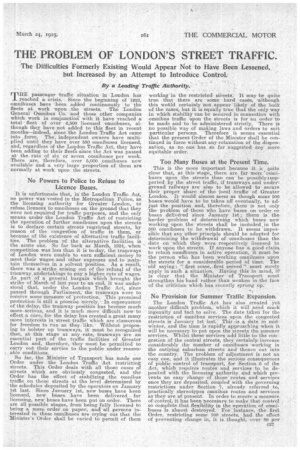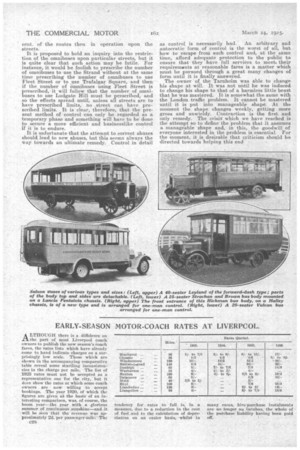THE PROBLEM OF LONDON'S STREET TRAFFIC.
Page 11

Page 12

If you've noticed an error in this article please click here to report it so we can fix it.
The Difficulties Formerly Existing Would Appear Not to Have Been Lessened, but Increased by an Attempt to Introduce Control.
By a Leading Traffic Authority.
T"Epassenger -traffic situation in London has reached a crisis. Since the beginning of 1923, omnibuses have been added continuously to the fleets at work upon the streets. The London General Omnibus Co.and those other companies which work in conjunction with it have reached a total fleet of over 4,500 licensed omnibuses, although they have not added to this' fleet in recent months—indeed, since the London Traffic Act came into force. The. independent owners have multiplied until they have over 550 omnibuses licensed, and, regardless of the London Traffic Act, they have been adding to their Reef's since the Act was passed at the rate of six or seven omnibuses per week. There are, therefore, over 5,000 omnibuses now available and a very large proportion of them are normally at work upon the streets.
No Powers to Police to Refuse to Licence Buses.
It is unfortunate that, in the London Traffic Aet, no power was vested in the Metropolitan Police, as the licensing authority for Greater London to refuse licences to omnibuses on the ground that were not required for traffic purposes' and the only means under the London Traffic Act of restricting the operation of further omnibuses upon the streets is to declare certain streets restricted streets, by reaeon of the congestion of traffic in them, or because of the existence of alternative traffic facilities. The problem of the alternative facilities is the acute one. So far back as March, 1924, when competition was less than it is to-day, the tramways of London were unable to earn sufficient money to meet their wages and other expenses and to maintain themselves in a solvent position. As a result, there was a strike arising out of the refusal of the tramway undertakings to pay a higher rate of wages. As part of a general bargain which brought the strike of March of last year to an end, it was understood that, under the London Traffic Act, since passed through Parliament, the tramways were to receive some measure ofprotection. This promised protection is still a promise merely. In consequence of the delay, the tramway position has become much more serious, and it is much more difficult now to effect a cure, for the delay haa created a great many more interests in street traffic which are clamorous for freedom to run as they like.Without proposing to bolster up tramways, it must be recognized that, at this stage at any rate, tramways are an essential part of the traffic facilities of Greater London and, therefore, they must be permitted to carry out their service to the public under reasonable conditions.
So far, the Minister of Transport has made one Order under the London Traffic Act restricting streets. This Order deals with all those cases of streets which are obviously congested, and the Order has the effect of stabilizing the omnibus traffic on those streets at the level determined by the schedules deposited by the operators on January let last. Since January 1st, new buses have been licensed, new buses have been delivered for licensing, new buses have been put on order. There are all possible stages, from being fully licensed to being a mere order on paper, and all persons interested in these omnibuses are crying out that the Minister's Order shall be varied to permit of them
working in the restricted streets. It may be quite true that thereare some hard eases, -although this would certainly not appear likely of the bulk of the cases, but it is equally true that the only way in which stability can be secured in connection with omnibus traffic upon the streets is for an order to be made and 'to be administered strictly. There is no possible way of making laws and orders to suit particular persons. Therefore it seems essential that the present Order of the Minister shall be continued in force without any relaxation of the, dispensation, as no one has so far suggested any more equitable order.
Too Many Buses at the Present Time.
This is the more important because it ii quite clear that, at this stage,, there are far more 'omnibuses upon the streets than can be possibly }supported by the street traffic, if tramways and underground railways are also to be allowed to secure their proper share ofthe local traffic of Greater London. It would almost seem as though some 500 buses would have to be taken off eventually, to adjust the position and, therefore, there is not only the problem of • those who have buses on order or buses delivered since January 1st ; there is the harder problem of determining which buses now working upon the streets shall be included.in the 500 omnibuses to be withdrawn. It seems impossible that any other principle should be adopted for determining the withdrawal of omnibuses than the date on which they were respectively licensed to work upon the streets. If anyone has a good claim to retain omnibuses in active operation, it must be the persun who has been working omnibuses upon the streets for a considerable period of time. The -old saying ; first come, first served " must surely apply in such a, situation. Having this in mind, it is clear that the Minister of Transport must strengthen his hand rather than weaken in the face of the criticism which has recently sprung up.
No Provision for Summer Traffic Expansion.
The London Traffic Act has also created , yet another difficult problem, which it will need much ingenuity and tact to solve. The date taken for the restriction of omnibus services upon the congested streets is January 1st last.' _This j.s a date in midwinter, and the time is rapidly approaching when it will be necessary to put upon the streets the summer services. Whilst these services add little to the congestion of the central streets, they certainly, increase considerably the slumber of omnibuses working in
into the outlying suburban streets and thence out the country. The problem of adjustment is not an easy one, and it illustrates the serious consequences of public control Of transport, for Section 6 of the Act, which requires routes and services to be deposited with the licensing authority and whichprevents an easy change of those routes and services once they are deposited, coupled with the governing restrictions under Section '7, already referred to practically stereotypes omnibus routes and services as they are at present. In order to secure a measure of control, it has been necessary to make that control so complete that flexibility in the operation of omnibuses is almost destroyed. For instance. the first Order, restricting some 160 streets, had the effect of preventing change in, it is thought., over 80 per cent. of the routes then in operation upon the streets.
It is proposed to hold an inquiry into the restriction of the omnibuses upon particular streets, but it is quite clear that such action may be futile. For instance, it would be foolish to prescribe the number of omnibuses to use the Strand without at the same time prescribing the number of omnibuses to use Fleet Street or to use Trafalgar Square, and then if the number of omnibuses using Fleet Street is prescribed, it will follow that the number of omnibuses to use Ludgate Hill must be prescribed, and so the effects spread until, unless all streets are to have prescribed limits, no street can have prescribed limits. It is clear, therefore, that the present method of control can only be regarded as a temporary phase and something will have to be done to secure a more efficient and businesslike control if it is to endure.
It is unfortunate that the attempt to correct abuses should lead to new abuses, but this seems always the way towards an ultimate remedy. Control in detail as control is necessarily bad. An arbitrary and autocratic form of control is the worst of all, but how to escape from such control and, at the same time, afford adequate protection to the public to ensure that they have full servides to meet, their requirements at reasonable fares is a matter which must be pursued through a great many changes of form until it is finally answered.
The owner of the Tarnholm was able to change his shape at will. It was not until he was induced to change his shape to that of a harmless little beast that. he was mastered. It is somewhat the same with the London traffic problem. It cannot be mastered until it is put into manageable shape. At the moment the shape changes weekly, getting more gross and unwieldy. Contraction is the first and only remedy. The crisis which we have reached is the attempt so to define the problem that it assumes a manageable shape and, in this, the goodwill of everyone interested in the problem is essential. For the moment, it is desirable that criticism should be directed towards helping this end
























































